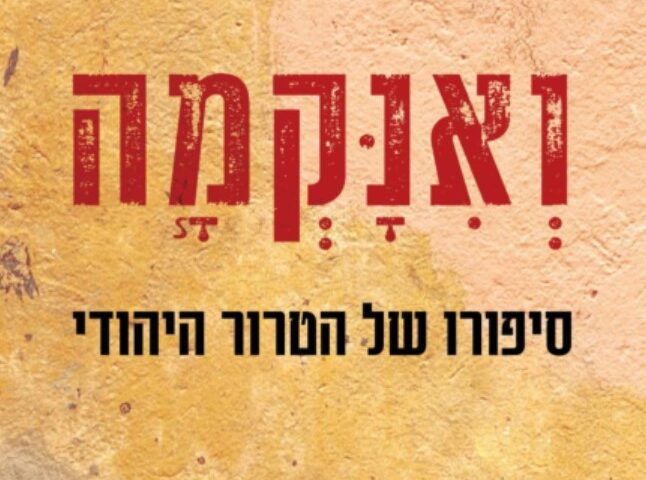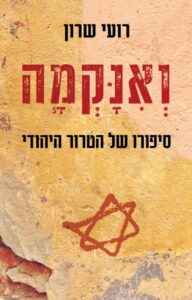Alt+SHIFT: Jewish Terror

Alt+SHIFT is the keyboard shortcut allowing us quick transition between input languages on our keyboards—for many readers of TRADITION that’s the move from Hebrew to English (and back again). Yitzchak Blau continues this Tradition Online series offering his insider’s look into trends, ideas, and writings in the Israeli Religious Zionist world helping readers from the Anglo sphere to Alt+SHIFT and gain insight into worthwhile material available only in Hebrew. See the archive of all columns in this series.
Roi Sharon, VeInakma: Sippuro shel haTeror haYehudi (Kinneret-Zmora Bitan), 250 pages
Two Ukrainians grabbed a sixteen year old Jewish boy and dragged him into the car. One strangled the boy while the other held his hands down. They drove to the forest, hit the victim over the head with a crowbar, poured gasoline over the body, and burned it.
In a four-and-a-half-year period, twenty-five synagogues in Iraq were torched and no criminals were apprehended.
Reading such accounts justifiably fill us with anger at the anti-Semitism and moral corruption in the broader world. Tragically, with identifying details changed, both actually recount the behavior of Israeli Jews. Three men from Adam killed Mohammed Abu Hadid from Shuafat in the manner described above. The second account reflects the fate of churches and mosques in Israel between 2011 and July 2015. Roi Sharon, former reporter for Ma’ariv and later for Kan 11, does a great service in recording the too many cases of Jewish violence since the 1990s. Due to his self-imposed time frame, he does not address earlier atrocities, such as Yonah Avrushmi lobbing a grenade at a Peace Now demonstration which killed Emil Grunzweig or the many violent acts of the 1980s Jewish Underground (for this see Haggai Segal’s excellent Ahim Yekarim). Even so, the reader will be surprised by the catalog of numerous acts of Jewish violence against random Palestinians.
[Read the book’s preface here.]
Sharon does not play the moral equivalency game and he forthrightly states that the Palestinians have a far worse track record. Many more Palestinians support terror and many more of them are willing to engage in violence against Israeli civilians. However, that does not change the reality that Jewish Israeli society has a problem. In the period under review, Baruch Goldstein, the Kahalani brothers, Gur Hemel, the Bat Ayin Underground, Eden Natan Za’ada, Asher Vizgin, Jack Teitel, Yosef Hayim Ben-David, and Amiram Ben-Uliel all murdered Palestinians. This list does not include unsolved murders or damages to property.
One can divide the list into murderers who are part of a larger ideological group and lone wolves acting without support. Sharon identifies three motivations fueling the violence. Some desire vengeance after Palestinian terrorists kill Jews, others want to create havoc and prevent particular political moves (such as the Gaza disengagement), while a third group is delusional in believing their crimes will hasten the messianic era. Those who sought to blow up the Dome of the Rock in the 1980s serve as a prime example of the third category.
The reader quickly notices the recurring names in the book’s thirteen chapters. Places like Yitzhar and Kefar Tapuah, figures such as Meir Kahane and R. Yitzchak Ginsburg all appears multiple times. It is not difficult to locate where the murderous ideology comes from. The Religious Zionist community is overrepresented among the killers. Furthermore, certain rabbinic works encourage such violence. R. Ginsburg wrote an essay extolling Baruch Goldstein, and both R. Ido Elba and R. Yossi Elitzur wrote that, in wartime, Jews can kill the women and children of the enemy.
Missing from the book is any real discussion of the different Religious Zionist voices opposing violence. In the 1980s and 1990s, R. Yehuda Amital and R. Aharon Lichtenstein were the prominent moral critics. Today, one might point to R. Yuval Sherlo and R. Mosheh Lichtenstein. Studying their mode of expression and their range of influence and contrasting them with other rabbinic voices against harming innocent Palestinians would prove instructive. In this regard, revisiting R. Lichtenstein’s response to certain rabbinic voices following Baruch Goldstein’s funeral (TRADITION, Summer 1994) reminds us how much we miss his clear moral vision in our day.
Sadly, the aggression has turned towards other Jews as well. The group called Tag Mehir has damaged army property and thrown rocks at soldiers. Attitudes towards the wing of the Shabak (the General Security Agency) dedicated to stopping Jewish crime have been far worse. Families of agents meet harassment outside of their homes and the agents have been referred to as moserim with explicit allusion to halakhic sources that allow killing such a “traitor.” Let us recall that we are talking about people trying to prevent the murder of innocents.
A powerful illustration of this occurred in 2018. On a Friday night near Yitzhar, in the Shomron, a boulder landed on a Palestinian car and killed a mother. Inhabitants of Yitzhar realized that the Shabak would come on Shabbat morning and interrogate the yeshiva students at Yeshivat Peri haAretz in Rehalim and they received a pesak allowing them to drive on Shabbat to the yeshiva to instruct the students about withstanding interrogations. Such a ruling relates to the Shabak as a dangerous enemy—equivalent to the Okhrana, Gestapo, or KGB.
In July 2015, Ben-Uliel firebombed a home in Kefar Duma killing several Palestinians including an eighteen-month old toddler named Ali Dawabesheh. At a wedding that December, Jewish guests danced while holding various weapons and a picture of Dawabasheh with one guest filmed stabbing the picture. The overwhelming majority of the Religious Zionist world was sickened by this video but it is time to admit that we have a serious problem. More than a few wild weeds in our own garden, a dangerous and evil growth exists that needs to be opposed and eradicated.
Yitzchak Blau, Rosh Yeshivat Orayta in Jerusalem’s Old City, is an Associate Editor of TRADITION.
